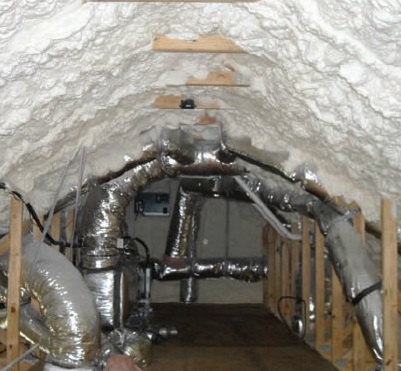The Foam Insulation Products Used In AZ Homes

Foam insulation products used in Phoenix, Tucson, & northern Arizona vary by environment and type of project. Open cell foam insulation is standard in the desert environment of Phoenix and Tucson. But closed cell foam can be found in damp crawl spaces in some areas of Northern Arizona.
The following article covers:
- Application methods: Spray foam vs. Injected foam
- Open cell and closed cell foam insulation
- Suitable & unsuitable applications for open cell
- Suitable & unsuitable applications for closed cell
- Foam insulation fire code compliance in residential attics
- Base materials and manufacturing methods
This article covers the topics mentioned above as they relate to the hot and dry Arizona climate.
Foam Insulation Differences: Spray Foam vs. Injected Foam
Foam insulation for residential homes in Phoenix and Tucson is broken down into two application categories – spray foam insulation and injected foam wall insulation. Spray foam insulation can be open cell or closed cell and comes in a wide variety of densities. Injected foam is usually closed cell with a narrow density range.

Spray Foam Insulation
Spray foam is foam insulation that is spray applied as a liquid into open cavities such as exposed wall stud cavities in new construction. The liquid rapidly expands and transforms into foam.
Injected Foam Insulation
Pre-expanded foam insulation that is injected into enclosed cavities. The foam is fully expanded before it is injected into an enclosed cavity with a high-pressure pump.
Where are spray foam and injected foam insulation used?
Spray Foam – New Construction & Existing Attics
New construction and existing attics are the standard application environments for spray foam.

Spray foam has a robust uncontrolled expansion as it transforms from a liquid to foam. The expansion forces of spray foam would break apart an enclosed block or wood stud cavity. As a result, the only suitable application for spray foam is into open cavities where it can freely expand.
Spray foam also has high amounts of adhesives, so it sticks to everything it touches. It is challenging to remove once attached to a surface. Consequently, it should not be used anywhere besides new construction and attics.
Injected Foam – Existing Block, Brick, & Wood Stud Walls
Existing block, brick, and wood stud walls are the standard application environments for injected foam.
Injected foam is a pre-expanded low adhesive material. Applying injected foam to an open stud cavity would cause the foam to fall out of the stud cavity immediately. Injected foam is engineered to mold to the voids in a fully enclosed cavity.
Residential injected foam is water-based with low adhesive content. Unlike spray foam, if injected foam contacts finished surfaces, it is easy to clean up.
Foam Insulation In Phoenix For Existing Walls
Injected foam can be installed in all homes in Valley except for historic double brick homes built before 1930. Typically, the walls on old double brick homes in Phoenix are solid so their is no room for insulation.
Foam Insulation In Tucson For Existing Walls
With the exception of adobe brick homes, injected foam insulation can be installed in all Tucson homes. Adobe block is soft and solid all the way through. There is no space to install foam inside the block.
The difference between open cell & closed cell foam insulation.

Foam insulation is closed cell when more than 50% of the cells are closed. Conversely, if less than 50% of the cells are closed, it is considered open cell foam.
Generally, the higher the density of the foam insulation, the higher the percentage of closed cells.
Pounds per cubic foot (lb ft³) is the standard density measurement of foam insulation.
Common Foam Insulation Densities
| 0.4 lb ft³ open cell | New construction walls |
| 0.5 lb ft³ open cell | New construction & existing attics |
| 0.75 lb ft³ closed cell | Existing block & wood stud walls |
| 2.0 lb ft³ closed cell | New construction in humid climates |
| 2.5 – 3 lb ft³ closed cell | Roofing material for flat roofs |
What type of foam is the most energy-efficient?
Closed foam is the most energy-efficient per inch of depth. However, most of the energy efficiency, or heat flow resistance, occurs in the first inch.
High-density closed cell foam insulation is also the most expensive foam insulation material. Additionally, if you apply closed cell at more than 2” of depth, your labor costs will double.
If closed cell foam insulation is the most energy-efficient, why isn’t it used everywhere?
Foam insulation is a high-performance material. Most of the heat flow resistance occurs in the first inch of foam. As you apply additional inches of depth to the foam insulation, each inch has less of an impact than the previous inch.


At 1″ depth closed cell foam is noticeably better than open cell foam. However, at 5″ depth they are nearly equal. Consequently, If there is adequate space available open cell foam will perform at the same level as closed cell foam for a fraction of the cost.
You should only use closed cell foam in situations where you cannot use open cell foam.
Applications Where You Should Not Use Open Cell Foam Insulation
Existing Walls
Due to the limited space in existing walls, you cannot use open cell foam insulation for retrofit applications. The expansion of the foam will break the wall apart, even concrete block walls.
Also, obstructions such as existing fiberglass insulation limit the space available for foam insulation. In areas with limited space available, closed cell foam provides more energy efficiency than open cell foam.
Humid Environments
You cannot use open cell foam in humid climates. Short-term moisture exposure will not harm open cell foam. For example, a roof leak that soaks open cell foam with water for a few months. However, temperature variations in wet climates will cause long-term moisture condensation inside of open cell foam. Consistent years-long moisture exposure will eventually damage open cell foam.
Conversely, humidity does not condensate inside of closed cell foam. With closed cell, moisture condensates on the surface of the foam where it can quickly evaporate. For this reason, closed cell is the preferred foam product for humid environments.
In new construction projects in the dry climates of Phoenix and Tucson, closed cell foam insulation is rarely used as an insulating product.
Areas With Two Inches Or Less Of Space
If you have three inches or more of space available open cell foam insulation is preferred over close cell. There are minimal performance differences between open cell and closed cell at three inches of depth. At five inches deep, open cell and closed cell are virtually identical when it comes to energy efficiency.
However, at one inch deep, closed cell foam insulation is a better product in terms of energy efficiency than open cell foam. In the Phoenix and Tucson areas, new construction projects where there is 2×2 furring on block walls are ideal applications for closed cell foam insulation.
Exterior Surfaces
On exterior applications, an elastomeric coating must be applied to protect foam insulation from the sun and rain. For this reason, roofing contractors use high density closed cell foam for foam roofing projects. The elastomeric coating can applied to open cell foam with a sprayer. However, it cannot be rolled into the foam because open cell foam is to soft. Therefore, closed cell foam insulation is the only product suitable for exterior applications.
Applications Where You Should Not Use Closed Cell Foam Insulation
Due to its prohibitive cost, you should use closed cell foam only in situations where there are no other options. However, similar to open cell foam insulation, there are also installation limitations with closed cell foam.
Existing Attics
In the Phoenix and Tucson areas, builders locate all HVAC ductwork in the attic. Therefore, foam insulation is applied to the roof deck to enclose the ductwork within the insulated envelope. Spraying the foam to the roof protects the ductwork from the extreme heat. But it also eliminates the option of using closed cell foam insulation.
Due to its low expansion rate, closed cell foam insulation must be sprayed perpendicular to the surface to which it is applied. Spraying closed cell foam at an angle causes uneven build-up in the foam. In turn, irregular build-up creates air pockets, which are the source of air leaks.
Consequently, air leaks significantly reduce the energy efficiency of the foam. For this reason, you should never use closed cell foam to insulate an existing attic in Arizona
Fire Code Compliance
All closed cell foam products require a spark resistant coating if they reach a depth greater than two inches in open interconnected cavities. For example, in an existing attic.
There are open cell foam products that do a much better job of insulating the eaves of an attic. Also, some open cell foam products do not require a spark resistant coating. Unlike closed cell foam, they are fire code compliant out of the barrel.
What foam insulation products are fire code compliant in an attic without a coating or modifications to the attic?
Open cell polyurethane foam insulation with sucrose is the only product that is fire code compliant in an attic straight without additional modifications.
If there is no sucrose in the foam insulation, the following steps must be taken to make the foam fire code compliant, no exceptions!
- Apply a spark resistant coating to the surface of the foam.
- Seal all wire and plumbing penetrations with a fire-rated sealant. Additionally, install a fire rated attic access hatch.
- Both A and B, depending on the product specifications.
Why would a contractor install a product without sucrose if additional steps are needed for foam fire code compliance?
It is challenging to work with sucrose based foam insulation. Many foam insulation contractors refer to sucrose products as “gray rain.” If the temperatures and ratios are not precise when the product is applied, it falls off of the roof in tiny gray drops. However, if your application technician has experience sucrose based foam, installation issues do not occur.
Polyurethane based foams are not fire-code compliant out of the barrel. However, they cost less and are much more forgiving to install than sucrose based products. In new construction, it is easy to apply the foam followed by a spark resistant coating because there is no drywall installed at the time of the foam application.
Many foam insulation products do not require a spark resistant coating if there is a fire-rated attic access hatch in the ceiling. Additionally, all wire and plumbing penetrations into the attic must be fire sealed. Typically the electricians and plumbers fire seal the electrical and plumbing penetrations in all new construction projects. In this situation, all a foam insulation contractor needs to do is install a fire rated attic access hatch.
Unfortunately, in existing attics, there is no fire sealing at the wire and plumbing penetrations. Attic access hatches are not fire rated. Also, it is virtually impossible to install a spark resistant coating in the eves without missing many areas. Therefore, the only way to foam insulate an existing attic and meet the fire code is to install a sucrose based foam.
How can I tell if the foam I am purchasing is fire code compliant?
Unless you are a trained professional, you cannot tell by looking at the foam. To the untrained eye, foam insulation products that are not fire-code compliant out-of-the-barrel are indistinguishable from fire-code compliant products.
The only way to know if a spray foam insulation product is fire code compliant is to read the product specifications. It would be best if you also verified on the day of installation that the correct product is applied. You can do this by looking at the label on the barrel in the foam contractors truck.
Retrofitting attics with foam insulation products that are not fire code compliant has been a reoccurring problem in Phoenix and Tucson over the years. Many contractors mistakenly believe the products they apply are fire code compliant in an existing attic. They believe this because their products are fire code compliant in new construction.
However, most foam products are fire code compliant in new construction because builders require plumbers and electricians fire seal all penetrations into the attic. Conversely, most existing homes do not have fire sealed penetrations, so new construction foam is not compliant in an existing home.
Foam Insulation Base Material
Most foam insulation is polyurethane-based. Additional products include sucrose/polyurethane, urea-formaldehyde, and tri-polymer plastic resin.
Polyurethane
Insulation, roofing material, floatation material, furniture padding, paint coating, and many other products are polyurethane-based. If applied correctly, polyurethane is durable, inert, and long-lasting.
Polyurethane foam insulation is manufactured on the job site. It has two liquid components, a resin, and a catalyst. First, you heat the two components. Then they are pumped through hoses at high pressure and meet at the tip of a spray gun. The resulting chemical reaction transforms the liquid into foam insulation in about ten seconds.
Most of the curing takes place in the first minute after the foam is applied, but it does not entirely cure for 24 hours.
Polyurethane based products have a strong odor. Water-blown polyurethane products have slightly less odor than solvent-blown products.
Sucrose/polyurethane
Sucrose based foam is a polyurethane foam that has sucrose added to it to make it fire code compliant. It is only available as an open cell product.
Sucrose based products are water blown and have a strong odor.
Urea-formaldehyde
Liquid urea-formaldehyde foam is for commercial new construction block walls. The liquid-based components are mixed to form a foam product and then pumped into block walls. Due to the formaldehyde off-gassing that occurs in the 72-hour curing faze, liquid urea-formaldehyde foam is only used in open-air construction sites. For example, big box stores or government buildings. Open-air construction sites allow the off-gassing to dissipate quickly.
After liquid urea-formaldehyde products cure, they become inert plastic and no longer off-gas. Urea-formaldehyde foam has a strong odor while it cures.
Tri-polymer Resin
Tri-polymer foam is a plastic resin that is mixed with water and a foaming agent to make foam insulation. The insulation is then injected into existing wall cavities.
Tri-polymer resins start as urea-formaldehyde in the manufacturing facility. The foam product is manufactured and allowed to cure. After the off-gassing is complete, the product is ground into a dry plastic resin by the manufacturer.
The resin is reconstituted on-site by mixing it with hot water and a foaming agent. The finished plastic product is inert and only off-gasses water vapor during the 24-hr curing phase.
Tri-polymer resin foam has no odor while curing.
Conclusion
Foam insulation is a high-performance product that increases comfort and lowers energy consumption. However, to work correctly, each project must receive the most suitable foam insulation product. Also, since foam insulation is made on-site, it is vital to hire a reputable, experienced company to install the foam. When appropriately installed, foam insulation is a safe, energy-efficient product that will last a lifetime.


